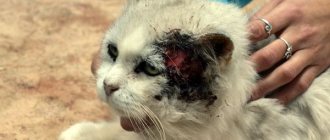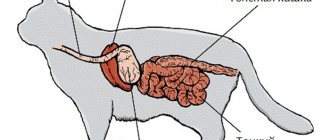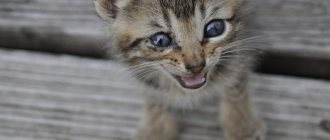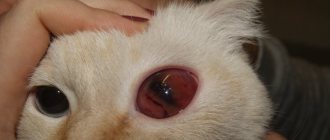Causes
The most common causes of sore throat in cats are calcivirus, herpes, chlamydia, mycoplasma and rhinovirus infections. However, viruses rarely affect a healthy animal or the absence of provoking factors.
- Eating cold, poorly defrosted food or water.
- Injuries, especially from chicken or fish bones.
- Decreased immunity.
- Diseases of the teeth or gums.
- Inhalation of toxic fumes or gases.
Sometimes the main viral sore throat can be complicated by the addition of a secondary infection.
Types of sore throat
There are 4 main types of sore throat in cats:
- Catarrhal – weak signs of inflammation. Tonsils rarely increase in size, slight redness. Predominant in viral infections.
- Ulcerative – characterized by the presence of ulcers in the tonsil area.
- Purulent - acts as a complication of catarrhal when a bacterial infection is attached. Severe swelling of the pharynx, high temperature and shortness of breath.
- Diphtheria (lobar) - caused by bacteria of the species Corynebacterium diphtheriae, a distinctive feature is the presence of plaque and films on the tonsils; when you try to remove them, bleeding of the mucous membranes begins. Rapid development of the disease and death from suffocation are possible.
Signs
Fortunately, in cats, sore throat occurs in a mild catarrhal form. Typically, the body temperature remains normal or slightly rises, difficulty swallowing and coughing occur. The pet may try to get rid of the “foreign body” by frequently opening its mouth and moving its tongue.
Signs of a sore throat also include:
- Hoarse voice or lack thereof.
- Profuse salivation. You may foam at the mouth.
- Refusal of food.
- Formation of ulcers on the mucous membrane (a sign of calcivirosis).
- The appearance of discharge from the nose or eyes, sneezing.
- Enlargement of the cervical and submandibular lymph nodes.
When a bacterial infection occurs, the condition worsens - a high temperature appears, shortness of breath, the tonsils become greatly enlarged, and the oropharynx turns red. The plaque takes on a purulent or serous character.
Diagnostics
The first step is to determine whether there is a viral or bacterial infection. A routine blood test will help you do this. If there is an increased number of white blood cells, bacteria may be present.
It is also necessary to conduct a serological blood test for calcivirus or herpes infection. Bacterial analysis is carried out by inoculating material from scrapings from the tonsils.
In cats, it is difficult to examine the pharyngeal cavity, so laryngoscopy is used for this - a special tube with a video beacon, which is inserted into the mouth.
It is also necessary to do a culture of the nasal discharge and mouth to detect chlamydial infection.
To exclude collapse of the trachea or the presence of a foreign body, an x-ray is performed to diagnose the neck area.
Treatment
One of the first ways to help a cat with a sore throat is a special diet. Due to problems with swallowing and chewing, it is worth giving her only soft food, in the first days of illness - puree. Food should be warm and nutritious. Broths, vegetable and meat purees, as well as fermented milk products are suitable for these purposes. You can use baby food.
Provide your cat with peace. Try to move her sleeping place to a place that is not easily accessible, exclude active games and try to disturb the animal as little as possible.
Catarrhal form is treated by treating the throat with antiseptic solutions - furatsilin, a weak solution of potassium permanganate. You can treat the oral cavity with a spray or Lugol's solution.
If there is no purulent process (this is very important), you can apply local warming compresses to the neck area.
For viral infections, it is advisable to use immunomodulators - Maksidin, Immunofan, as well as adaptogens - Gamavit.
If tests show the presence of a bacterial infection, then antibiotic treatment must be prescribed. Amoxicillin and norulfazole are used for these purposes. The course should be at least 14 days with support from drugs for intestinal microflora (Lactobifadol, Bactoneotime).
Antipyretics (ketofen, Loxicom) and painkillers (aspirin) are prescribed symptomatically.
Cats should not be given paracetamol!!
Symptoms and treatment of throat diseases in cats
Medical otolaryngologists are still sometimes called "ear, nose and throat" doctors. Following this tradition, a number of visitors to our forum ask to talk about the treatment of “throat diseases” of cats,” apparently implying tonsillitis, inflammation, swelling, spasm and stenosis of the larynx.
In case of acute inflammation of the tonsils (tonsillitis), animals' body temperature rises, depression, lethargy, drooling, and difficulty swallowing appear, which causes a deterioration in appetite or refusal to feed. A cough appears - at first it is dry, then in most cases it is wet (productive). The voice changes (becomes hoarse, abrupt). In the upper part of the neck (in the submandibular spaces), enlarged lymph nodes are palpated; when pressed, the animal exhibits a painful reaction. The tonsils turn red, increase in size, and may partially block the lumen of the pharyngeal ring.
Depending on the nature and stage of the inflammatory process, the tonsils may be covered with clear or whitish mucus and pus; abscesses and erosions (small ulcers) may appear on them. Chronic tonsillitis is characterized by long-term manifestation (weeks and months) of the same symptoms, which are much less pronounced than in the acute course.
Inflammation of the larynx ( laryngitis ) is manifested by a cough (initially dry, and later it is accompanied by the discharge of sputum), changes in meowing (hoarseness, loss of voice, etc.), difficulty swallowing and taking water, a variable increase in body temperature and depression. The duration of the disease usually does not exceed 7-10 days. Under unfavorable conditions, it can develop into a subacute or chronic form. They are accompanied by the same, but less pronounced clinical signs as acute laryngitis, which persist for several weeks and even over a month. Chronic laryngitis may worsen.
Gargle
The next way to deal with a sore throat is gargling. But there is disagreement among experts on this matter. Some believe that this is a good method of struggle, others, on the contrary, believe that gargling worsens irritation of the throat mucosa. Still others argue that it is better to irrigate instead of rinsing.
If there is no consensus, then everything depends on the patient. Only he can decide whether to gargle or irrigate.
For rinsing, it is recommended to use simple boiled warm water, solutions of medicinal herbs, or a solution with salt, baking soda and iodine. This solution should not be taken by patients with thyroid disease.
Another effective treatment method is inhalation. The results from inhalations can be compared with the results of physical procedures.
Inhalations should be carried out for no more than 7 minutes. The water should be between 85-90 degrees. It is not recommended to eat or drink for an hour after the procedure. Otherwise, there will be no result from inhalation.
We invite you to familiarize yourself with Deutsche DoggeFCI No. 235 Country of origin: Height at withers: Color: Other names: Germany males at least 80 cm, females at least 72 cm black, blue, fawn, merle, brindle Great Dane The homeland of the modern Great Dane is, of course, Germany. In the 10th century, ancient Germanic tribes developed a Code of forest hunting laws - “Geoponics”, which describes seven types of mastiff dogs, including dogs for baiting boar (wild boar) and bear. These distant descendants of the Molosser, crossed, according to some historians, with English hunting dogs, unexpectedly appeared in the 15th century in the form of modern Great Danes. They had many local names: Great Dane (which had nothing in common with Denmark), Old German Mastiff, Bulenbeiser, Ulm Dane, etc. In 1879, the Germans decided to put an end to such diversity, and at a meeting of German breeders chaired by Dr. Bodinus, it was decided to recognize Great Dane is the national breed of Germany and, having abolished the previous names, from now on call it the Great Dane. The beginning of systematic breeding of Great Danes coincides with the creation of the National Dog Club of Germany (DDC 1888 eV) on January 12, 1888 and the publication of the first volume of the “Great Dane Stud Book” (DDZB). The target of breeding at that time was the nursery “Plavia” of Mark Hartenstein, famous for the blue mastiffs Faust-1 and Faust-II included in the stud book. No less famous are Mr. Messter and the best dogs Nero-I, Nero-II, Mentor, Sultan-I, born in his kennel “Nill” in Stuttgart. Nero-I gave a genetically rich inheritance. It was a magnificent animal of impressive stature, brindle in color, with a beautiful head, a voluminous muzzle, a short ear and an elegant body. Other, no less glorious nicknames also appeared in the pedigrees: Minka, Flora, Sara, Riego, Bella, Harras, Tyrus, Wotan. Most of these dogs were fawn and brindle in color, but Sara (b. 1886 Tirus x Bella) was a distinctly stylish harlequin. Meanwhile, improvement of the breed continued in Germany. At the beginning of the 20th century, several animals appeared that were apparently the result of minor genetic mutations in the direction of the desired standard and were recognized as such by German breeders. The beginning of a new wave of champions was laid by the famous fawn male Bosko vd Saalburg (b. August 8, 1921) from the kennel of Karl Farber. Thanks to the work of this breeder, the type of modern Great Dane was finally formed. This allowed the Loheland kennel to obtain, perhaps, the best Great Danes for that time. It was here that the champions Fionne and Ferguni appeared, and the letter F became the symbol of the breed. Ferguni, inbred with her father (Bosko), produced a magnificent litter of N, which had an extraordinary influence on future Great Dane pedigrees. The combination of beauty, poise and health of these dogs was beyond comparison. Without her, the Great Dane would never have achieved the title of "Apollo of dogs." Breeding Great Danes in Germany is allowed only separately according to color groups. Thus, it is unacceptable to breed a merle dog with a black one if the latter is not a descendant of merle dogs. Blacks can be crossed with blacks and blues to prevent lightening of the blue color and to maintain the deep blue-black tone of black dogs; but since blacks carry recessive blue from under blues, they should not be partners with merles. Such matings can produce blue spots or specks on the main white background and spoil the picture of a real harlequin. Fawn and brindle dogs only mate with each other. Dogs in this group are considered by experts as reference dogs. That is why at the beginning of the 20th century, in order to bring the number of black, marbled and blue dogs to the required level, German breeders (after lengthy discussions) allowed bitches of these colors to be bred with the best brindle producer Dolf vd Saalburg. In 1945, in Hamburg, due to the lack of a marble male, it was decided to breed a Harlequin female with the best fawn sire. The pedigrees of the Harlequin puppies from this litter included Fr. Some outstanding Great Danes trace their origins to these dogs. It so happened historically that the main breeding centers for the best Great Danes are concentrated in Germany to this day. As the creators of the breed, German breeders are undoubtedly leaders and determine the directions for further improvement of Great Danes and establish evaluation criteria. This is ensured by a large number of excellent producers, well-thought-out policies in breeding and special scientific developments. The population of Great Danes in the UK and USA is very homogeneous. When you look at Great Dane rings in England or the USA, thoughts about identical twins involuntarily come to mind. The American type of Great Dane is very different from the European type that is so familiar to us. “Americans” are mostly fawn in color (the most respected in the USA), usually very tall, with a slightly elongated body, long back and loin. The head is long, narrow, dry, with a low forehead and a weakly defined transition from the forehead to the muzzle. The first Great Danes came to Russia even before the revolution. At the Hamburg Exhibition of 1869, eight Great Danes were exhibited for the first time. They made an indelible impression on the Russian emperor, and Alexander II acquired two dogs. However, the breed did not become widespread until the mid-60s. At the 1946 exhibition, only five Great Danes were presented, three of them of unknown origin. In the mid-60s, the basis of the Muscovy Great Dane population were black and blue dogs; there were almost no merle dogs. Fawns of domestic breeding also appeared, but obtained from blue ones, they had a gray-yellow color without masks. And finally, in the early 70s, significant changes took place. This period became a turning point in the history of the Russian population of Great Danes. Thanks to Zoovetsnab, many dogs imported from the GDR, Poland, Czechoslovakia and a number of other countries came to Russia. One can argue about their quality, but, undoubtedly, it was thanks to them that the number of Russian Great Danes has risen to a qualitatively new level. Moderate use of these sires made it possible to finally move on to breeding according to color variants. The Great Dane is one of the largest dogs in the world. It is safe to say that he is aware of this. The standard requires that even during maximum arousal he should not show any emotion either towards members of his family or towards strangers. And it seems that not a single Great Dane wants to conflict with the standard. You shouldn’t be surprised at the outward indifference that the dog bestows on strangers: he is an excellent watchman and protector of his property. His teeth are large, his jaws are powerful, and his head is large enough to figure out what to do in the event of an attack on his beloved owner or his property. The idea that in old age a Great Dane becomes a grump and a bore is a clear slander. Of course, he can become aggressive and even dangerous, but the reason for this may be illiterate upbringing and incorrect treatment of him in childhood. In this, the Great Dane is no different from small dogs, only it bites much more painfully. Innately intelligent, the Great Dane is more than just a dog. This is DOG superlative. Try to find a common language with him from early childhood, and then he will become a brilliant companion in all your endeavors. You can communicate with him on equal terms (especially since there is no need to bend over to look him in the eyes), he can even be your interlocutor - his gaze is so expressive and the facial expressions of his “face” are rich. The Great Dane is highly trainable (however, it is almost impossible to retrain it); with a properly designed training program, it is capable of service of any kind. However, the job of a bodyguard is most suitable for him. In addition, almost all Great Danes, due to their tendency to patronize the weaker members of their “pack,” can be unrivaled nannies. Leaving even the smallest child with your Great Dane, you don’t have to worry about his safety - no one will dare to harm him. Yarmolovich G.
To combat a sore throat, special lozenges will help. They contain antimicrobial compounds that have a beneficial effect on the mucous membrane of the throat.
general information
During a sore throat, the swallowing ring becomes infected, causing swelling of the throat and tonsils. The disease occurs due to infection of the cat with microorganisms such as staphylococci and streptococci and must be treated immediately. Even if a cat has never had a sore throat, this does not mean that this illness may not affect it. You need to carefully monitor the animal, and not miss the moment when your pet has a sore throat.
Staphylococcus in cats is a type of microorganism that causes diseases that are difficult to treat and have possible serious complications. This name unites a whole family of pathogenic microbes.
Streptococcus in cats is a type of microorganism that is caused by bacteria from the genus Streptococcus. It is considered the causative agent of severe pathological processes that require rapid response and relief.
Sore throat in cats is always a severe inflammation of the throat, larynx and tonsils, which can be identified by certain symptoms. It does not happen without pain, nasal discharge, swelling of the mucous membranes, and in especially severe cases it becomes difficult for the animal to swallow. This ailment, which is not dangerous at first glance, can become a serious problem for a pet.
Basic information, predisposing factors
As you know, edema is the pathological process of fluid accumulation in cells and intercellular space. As a result, the affected organ swells, and in most cases its functionality deteriorates sharply. In general, the same can be said about laryngeal edema.
In severe cases, it swells so much that it completely blocks the flow of air, which can even lead to the death of the animal from suffocation. However, even in relatively simple situations there is little pleasure from this pathology, since the cat cannot eat or drink. In addition, the pet may be very nervous (which is not surprising), and stress only leads to aggravation of the process. By the way, what are the causes of this pathology? There can be quite a lot of them, but we will give the main list:
- Allergy. Perhaps the most common and insidious reason. It occurs suddenly, quickly, and is often fatal, since the swelling in this case may well completely block the entire windpipe.
- Poisoning, including from drugs or household chemicals. It often occurs in conjunction with an allergic reaction, and therefore leads to even more serious consequences.
- Autoimmune pathology. In general, this also includes cases of idiopathy: this is when the true root cause of the disease cannot be established.
Types and signs
According to the nature of the development of the disease, two forms are distinguished:
- chronic – the animal’s throat hurts for several months.
- acute - develops instantly. The animal's temperature rises, it hurts the cat to swallow, and the number of leukocytes and ESR in the blood increases. It is more difficult to tolerate than chronic, but goes away quickly with well-chosen treatment.
According to the nature of the course of inflammation, depending on the microorganism that caused the disease, several types are distinguished:
- catarrhal - determined by tingling in the throat and pain when swallowing. In cats, the pharynx becomes inflamed, the tonsils are slightly enlarged, a whitish coating is noticeable on the tongue, the temperature is slightly higher than normal, and in rare cases the voice disappears.
- croupous - determined by swelling and compression of the swallowing ring, the temperature is 2-3 degrees above normal. When the disease is severe, breathing becomes impaired, shortness of breath appears, the cat refuses food and water, the throat hurts, and the mucous membrane becomes pale. A cough appears when trying to eat food, and unpleasant discharge comes out of the nose; the cat cannot meow, but can only wheeze.
- diphtheria - determined by a gray-white coating, a temperature much higher than normal, infection of the mucous membranes of the mouth and nose, and even blood. Happens rarely.
- ulcerative - determined by small ulcers on the pharyngeal mucosa, especially in the tonsil area. The temperature may be normal.
Treatment
Home treatment is allowed only if there are no serious complications and if the cat does not refuse food and water. In case of severe manifestations of the disease, you should immediately seek help from a doctor.
When treating a throat at home, you need to intensively support the animal’s body and increase immunity.
Recommended:
- place the cat in a warm room without drafts
- surround the animal with affection and care
- increase caloric intake and avoid hard-to-digest foods
- Give your pet only warm liquid food
If on the second day there are no changes for the better, and the animal still has a sore throat, you should urgently contact a specialist and show him the cat.
Based on the results of an examination of the throat, the veterinarian can prescribe the best ways to maintain the cat’s body:
- subcutaneous or intravenous glucose infusion
- alcohol compresses for warming
- immunostimulants
- in particularly difficult cases - antibiotic therapy and parallel strengthening of the intestinal microflora
It is strictly forbidden to prescribe antibiotics yourself to treat a sore throat in a cat. Recommendations should only be made by a specialist
Feeding and caring for a sick cat: what to do
Caring for a sick cat differs in a number of nuances:
- It is better to refuse dry food; you should use only high-quality natural food (rabbit, turkey, chicken), or ready-made canned food. Veterinarians recommend using holistic treatments from Acana, Hills, Eukanuba for this. When using “natural” meat and other components of the diet must be finely chopped.
- Feed a sick cat more often, but in small portions.
- It is necessary to maintain a stable, constant temperature in the room, avoiding sudden changes and drafts.
- It is better to avoid walking outside.
In any case, it is worth showing the animal to a veterinarian as soon as possible. Edema can develop rapidly, within a few minutes, and threaten the life of the animal. Your first aid in this case can significantly alleviate the cat’s condition and improve the prognosis.
- If your swelling is hot and red, you can try applying cold and go to an appointment;
- If there is swelling of the muzzle or lips, try to give the animal an antihistamine (if you have one at home) and go to a veterinary clinic in Krasnoyarsk as soon as possible. It is better to clarify the dosage of the drug by calling our clinic 7(391)2-179-779;
- If you see your cat's breathing deteriorating due to swelling in the face or any other part of the body, try to provide air flow. See your doctor as soon as possible. If breathing stops, it is necessary to perform artificial respiration through a napkin, carefully opening your mouth with it.
At the clinic, the doctor will urgently examine the animal and provide symptomatic therapy aimed at stabilizing the condition, and then conduct additional diagnostics to make a diagnosis.
Can a cat have a sore throat - 10 diseases of the oral cavity and pharynx in cats
In almost every member of the cat family, the oral cavity is a weak point, since the pet chews hard food or bones. When a cat has a sore throat, this may indicate a sore throat and other diseases associated with viruses and bacteria. With pathology, the pet's tonsils become enlarged, difficulty swallowing and other unpleasant symptoms arise. If pharynx diseases develop, you need to contact a veterinarian, who will examine the problem areas and tell the owners what to do to alleviate the cat’s suffering.
What to do if your cat has a sore throat?
Our center offers a service where you can call a veterinarian to your home in Moscow. Our competent veterinarian in Domodedovo will examine the animal, prescribe the necessary medications and determine whether additional diagnostics are needed.
Let's see what the owner may encounter. What are the common cat diseases, their symptoms and treatment?
One of the most common throat diseases in cats is sore throat or acute tonsillitis. Often, simple inflammation can develop into viral stomatitis. Therefore, it is necessary to closely monitor the animal in order to notice at the first signs when the cat has a sore throat, and to avoid complications with the help of timely treatment.
- general information
- Types and signs
- Treatment
Causes and symptoms of diseases
What is the danger of a foreign body?
If a kitten is constantly or at least occasionally allowed to chew bones and other hard foods, then there is a high probability of sores in the mouth. If a foreign body gets into the cheek or between the teeth, the cat becomes painful and feels uncomfortable. A similar danger for outdoor cats is represented by sticks and wood chips, which damage the mucous membranes or get stuck in the throat. It is possible to recognize the entry of a foreign body by the pet's frequent rubbing of the oral cavity in an attempt to get rid of the object.
Veterinarians emphasize to owners that if a cat cannot quickly eliminate a foreign body on its own, then it is necessary to contact a veterinarian. The specialist removes the object in the mouth under local or general anesthesia.
Manifestation of acute stomatitis
In kittens and adults, this disease is an inflammatory process of the oral mucosa that rapidly progresses. If stomatitis is not treated in time, it will be accompanied by pharyngitis and glossitis, as a result of which the pet’s tongue and throat become inflamed. The following negative factors can influence the progression of oral disease in cats:
- Calicivirus infection or herpes virus activity. Pathogenic microorganisms lead to an inflammatory process in which the pet experiences frequent sneezing, coughing and discharge from the nose and eyes. The animal develops ulcerative wounds of varying sizes.
- Irritation. This reaction can occur in a cat to chemicals, dyes, bleaches and other items used by humans in everyday life. If a large amount of such solutions is swallowed, the kitten may not be saved.
- Dental diseases and gingivitis. In cats, the tissue around the teeth is often damaged and inflamed, which leads to ulcers and other lesions of the mucous membrane.
Possible complications and consequences
Despite the conservative and surgical treatment, one should not exclude possible complications and consequences, including:
- loss of voice function;
- food entering the larynx and other organs of the respiratory tract;
- cough, shortness of breath, whistling when breathing, residual noise;
- gagging after eating;
- seam divergence;
- hematomas;
- aspiration pneumonia.
Complications after surgical treatment are observed in 30-40% of animals. For example, after resection of the larynx, pneumonia is diagnosed in 35-45% of patients. It should not be ruled out that the death of the pet may occur due to serious complications. The final result is influenced by the age, general condition of the pet, conditions of care and maintenance, chronic, congenital pathologies of the nervous system.
Please note that after the operation, if the clinic provides a medical examination service, leave the cat for a day under the supervision of veterinarians.
How is treatment and prevention carried out?
When something starts to interfere with your pet’s mouth and throat, it’s worth taking the cat to the veterinarian. This measure will allow you to prevent dangerous diseases or begin their treatment in time. In case of a pathological process in the pharynx, treatment with antiseptics and herbal decoctions with an astringent effect is required. During treatment, they adhere to a special diet and give the cat liquid food. Antibiotics are also prescribed for diseases that are complicated by a purulent process. Sore throat in cats and other diseases of similar localization are observed less frequently when preventive measures are carried out. For this purpose, monitor the animal’s diet and brush its teeth. It is not recommended to give your cat bones or other hard objects that could cause injury.
How to treat tumors in the throat?
The treatment regimen is determined by the veterinarian individually based on the etiology of the tumor; self-medication can harm the animal. If the throat is swollen due to cancer, surgery is performed. Excision of the tumor is carried out, capturing healthy tissue. A tracheostomy tube is often required to facilitate the breathing process.
If metastases are detected, chemotherapy is prescribed. Cytostatic drugs are used that prevent tumor development by destroying malignant cells. However, this method has many side effects. Drug treatment includes immunomodulatory agents, vitamin-mineral complexes, antibiotics (for suppuration). Papillomas can be treated with liquid nitrogen or laser.











